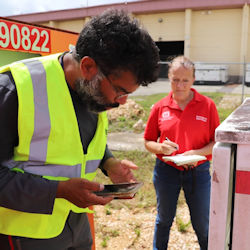Hazard Assessment, Analysis, and Evaluation
Assessment: The first critical step is to identify actual and potential physical and health hazards being used or needed in the workplace. This process is about gathering basic information that identifies the presence of hazards.
- Physical hazards can be things like moving objects, changing temperatures, bright lights, heavy or unwieldy objects, object that roll or pinch, equipment motions or actions, electrical connections, and sharp edges.
- Health hazards might be contact with harmful atmospheres, materials, chemicals, or radiation.
- Potential hazards include physical and health hazards that could reasonably be expected to cause injuries and illnesses.
Analysis: After finishing the walk-through, examine each task and work practice for specific hazards and needed hazard controls. Analysis involves a more detailed examination of the PPE being used, specific hazards, tasks, and other information such as related historical accident data. The process requires gathering enough information to allow effective evaluation.
Evaluation: An evaluation based on the results of the analysis is conducted next to judge the merit, value, and quality of PPE, equipment, and procedures. It usually follows an assessment and analysis and often concludes with recommendations or decisions.
Ultimately, the output of the assessment, analysis, and evaluation process includes recommendations to improve PPE-related equipment, procedures, materials, processes, and policies.
- Sources of electricity: Identify where electrical hazards exist.
- Sources of motion: Look for moving machinery or processes that might cause impacts.
- High temperatures: Find areas that could cause burns, eye injuries, or fires.
- Chemicals: Note the types of chemicals used in the workplace.
- Harmful dusts: Identify where harmful dust may be present.
- Light radiation: Check for sources like welding, brazing, cutting, and high-intensity lights.
- Falling objects: Be aware of places where objects could fall or be dropped.
- Sharp objects: Look for items that could cut, stab, or puncture.
- Biological hazards: Identify risks from blood or other potentially infectious materials.
Knowledge Check Choose the best answer for the question.
1-7. What phase of the hazards assessment, analysis, and evaluation of PPE hazards examines each task and work practice for specific hazards and needed hazard controls?
You forgot to answer the question!

